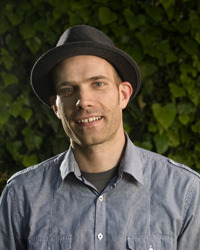Chris Baty's Blog, page 218
March 13, 2013
HQ Introductions: Hello!
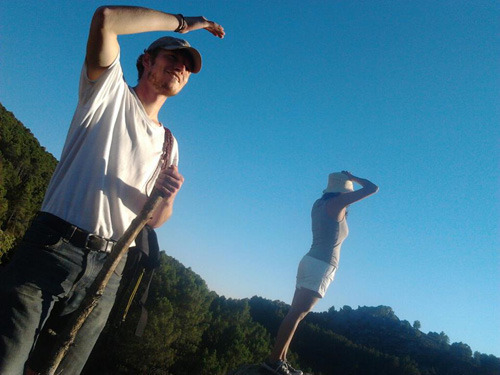
Dear estimable reader(s),
I am Michael Adamson. You may call me Mike, or any other permutation of my full name, or even something wholly unrelated. I literally cannot stop you. Once you’ve settled on your preferred pseudonym, know that I am announcing the auspicious beginnings of my internmentship with NaNoWriMo. I appear to have joined a prestigious community and expect only the best from it.
My chief occupation is traveling across time and space on the engines of imagination and relativity. I have explored the dark recesses of what is and what should never be, and come to you all bearing tidings. Unfortunately, the fabric of the cosmos is no place to raise children (not that I have any, but one likes to be prepared), so I make my abode in present-day Northern California.
All this space-time continuum nonsense may come as a shock. But, reader, I implore you, do not be alarmed! I am healthfully occupied in the real world, despite my mental wanderings. I received a B.A. in English Literature from the University of Colorado and have spent my time not using it in several different capacities.
Most recently, I was professionally engaged in the land of bulls, wine, hills that look like white elephants, and drinks that taste like licorice. I am speaking, of course, of Spain (Madrid, specifically). I worked as an assistant English teacher for high-school students, working painstakingly to give an American take on the language. My work was largely ignored by its intended audience, but I expect it will explode posthaste.
Now I am here with you, and am really quite pleased with that. If you desire to know more, know that my hobbies include reading science fiction (surprising? I should think not), dancing to rock-and-roll music that is far older than me, climbing mountains that are far, far older than that, and inhabiting the mercurial intersection of mischief, bravery, and stupidity.
Feel free to introduce yourself to me. I look forward to many future high-quality virtual engagements with high-quality virtual people.
— Mike
March 11, 2013
Photo Story: The Young Writers Program, Authors-to-be, and You
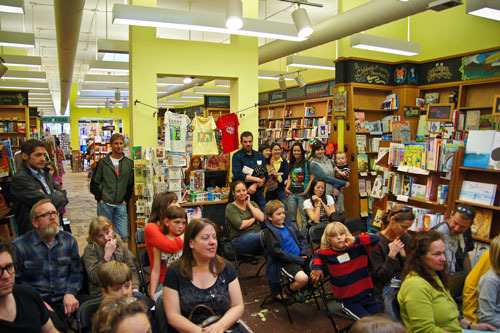
Eight daring YWP Wrimos picked up the microphone and shared their novels during the “Thank Goodness It’s Over” NaNoWriMo reading on February 10, 2013 at the Booksmith in San Francisco. The pictures below capture the faces of the bright young authors supported by NaNoWriMo, the Young Writers Program, and you. One day, maybe you’ll find their photos on the back jacket of their published novels. Until then, keep on writing, Junior Wrimos!
Here’s a shout out to our all-stars featured below:
North Oakland Community Charter School, Oakland, CA
Luca Campbell, Francesca Miller-Heller, Justice Petersen, Julian Rosenthal
Creative Arts Charter School, Oakland, CA
Marlowe Heier, Ronin Lanning
Clifford Elementary School, Redwood City, CA
Millen Quinn Alley, Leigh Danielle Alley
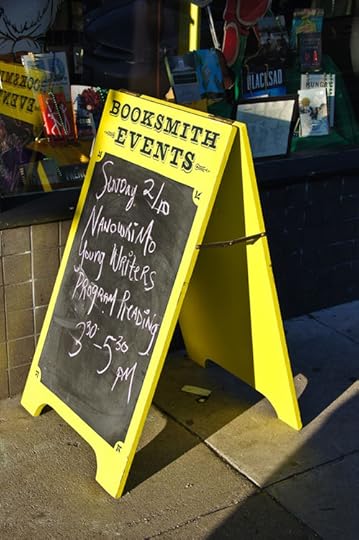
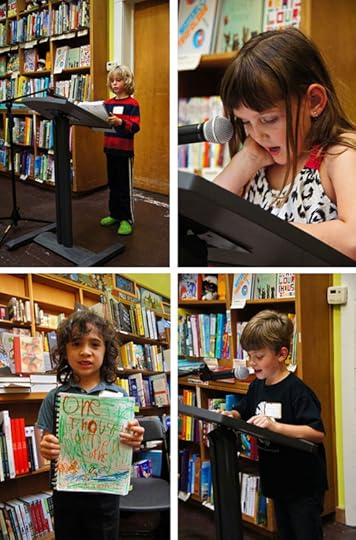
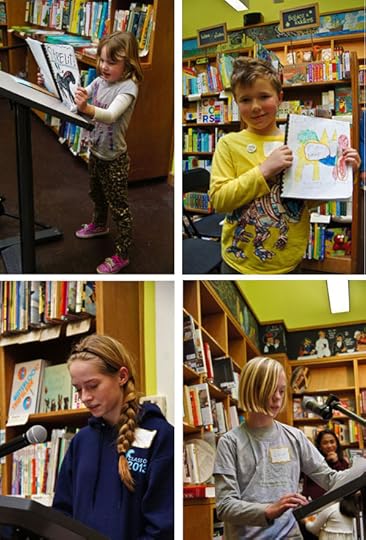

Photos by Ian Stevenson Photography.
Young writers, have you read your novels aloud to friends and family? Tell us about it!
— Andrea
March 8, 2013
Eight Ways Writing a Novel Can Broaden Your Horizons

Miriam Joy and Charley Robson are Wrimos, high-schoolers, and all-around all-stars, who’ve recently co-authored a book. St. Mallory’s Forever! was independently published this past month. As young writers themselves, they took the time to share just how writing a novel can enrich, empower, and edify:
Though the title of ‘published author’ can take time to achieve, we’ve proudly been writers for years. Both of us have been writing since before we hit ten. That’s all very well, you might say, but surely it’s not terribly fulfilling for young people to spend their free time staring at a backlit screen, drumming their fingers on the keyboard and plotting the defenestration of that mocking, blinking, monitor.
But apart from the proper usage of various antiquated torture devices, and the effects of different types of alcohol, we’ve also learned a few more philosophical—and, one might say, surprising—things:
Noveling has taught us to be interested in people, places and experiences that we would otherwise have ignored, to be sensitive to cultures we have no part in, and to be patient in our judgement of others’ thoughts and motivations.
Noveling has taught us to deal with our emotions in a positive, creative way, instead of allowing negativity to become too powerful. It’s allowed us to safely explore emotions we haven’t yet felt, or might never feel.
Noveling has taught us that skills of all kinds must be honed and practiced in order to generate improvement.
Noveling has taught us to make the most of whatever time we have, because even fifteen minutes can be useful.
Noveling has taught us to learn things for the sake of learning them, rather than to pass exams.
Noveling has opened our eyes to the beauty and intricacy of written language.
Noveling has taught us that everyone can be important. Even if they don’t particularly want to be.
Thus, we see there is much more to writing a novel than simply splattering words over a piece of paper. Noveling has taught us many things: inspiring things, thoughtful things, sometimes even difficult things.
But it couldn’t have taught us that without us first taking up the endeavour, and believing in it. The practice of writing a novel shouldn’t be put up on a shelf and regarded as a select art. It can teach you a thousand things about yourself, and the world around you, and it can also tell you something far simpler:
Noveling taught us that writing is fun. (Especially when you get to play god and break things, just because you can.)

Charley Robson, a proud “army brat”, has lived on every major continent on Earth and is currently attending her thirteenth school, a boarding school for girls in Dorset, South England. A prolific poet, one of her poems was awarded a place in the top 20 of a Daily Telegraph poetry competition in 2010.

Miriam Joy has lived in South-East London all her life, working through the state education system and trying to appear as normal as a fangirling nerd ever can. Recently, she became the assistant to the Teens Can Write Too! blog.
Top photo by Flickr user richardstupart.
March 6, 2013
A Guide to Camp NaNoWriMo 2013
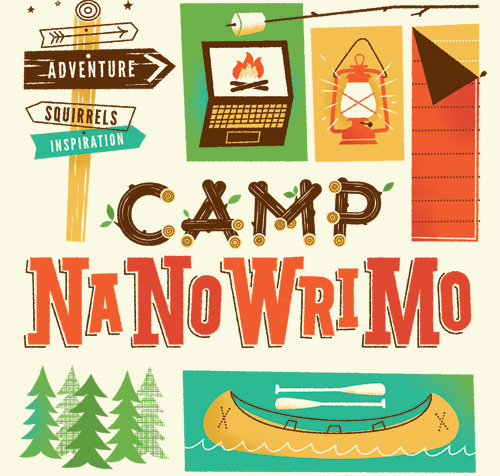
Writers, adventurers, explorers, one and all: Camp NaNoWriMo 2013 has officially launched! The gates have swung open for our very first April session; the cabins have been swept clean, Lake Blockbegone is rippling with inspiration, and the word-count targets are awaiting your aim. (Can’t join us in April? Mark your calendars for July!)
What is Camp NaNoWriMo? We like to call it an idyllic, virtual writers retreat, smack-dab in the middle of your crazy life. It’s a challenge to dash off the first draft of your ambitious writing project in just one month.
Now, before you head off in search of the ever-elusive Storysquatch, we thought we’d give you a quick reintroduction to the lay of the land. The two biggest changes? We’re introducing flexible word-count goals, and “Scripts” as an official genre!
The Word-Count Archery Range: Maybe, for whatever reason, 50K just wasn’t the right fit for you. Thankfully, you can now adjust your targets and take aim at a word-count goal anywhere from 10K to 999,999.
The Genre Troop HQs: Fly your flag proudly, Rebels and Frenzy-folk. We’ve made Scripts an official genre over at Camp. After all, the Script Frenzy flag can’t just be hidden away forever.
Writing a memoir, a second draft, or poetry? Select “Other” to enter a custom genre to properly strut your stuff.
Your Camp Cabin: Do you need silence to concentrate on writing your novel? Or do you find flashes of genius in the chatter of your fellow cabinmates? Choose your bunkmates based on age, shared genre, similar word-count goal, activity level, or by name!
The Arts and Crafts Tent: We’ve got some beautiful web badges ready for you to trumpet your participation at Camp. The strolling bear is in dire need of a name.
The Cantina and Souvenir Shop: Want to commemorate your time at the best Camp session yet? Check out the new t-shirt and other Camp goodies at the Cantina.
Want to help keep Camp going? Check out our Donation Station, and snag the new donor-only iron-on patch, poster, and more.
The Camp Fundraising Pier: Do you want to support Camp but can’t afford to donate yourself? Start a fundraising page and cast your net off the Fundraising Pier. You could earn a story consultation with acclaimed author and Wrimo, Gennifer Albin!
Will you be participating in Camp? What word-count goal will you shoot for?
March 4, 2013
R.L. Stine: On Writing Addictions, Challenging Himself, and ThrillerFest

This year, NaNoWriMo was sponsored by ThrillerFest, the world’s largest thriller-novel convention, which includes a writing school, the opportunity to pitch your thriller to fifty agents, and a celebration of thriller writers and readers.
Director-at-large, R.L. Stine, is one of the best-selling children’s authors in history with over 350 million copies sold of series including Goosebumps and Fear Street . Last fall, he released his second adult novel, Red Rain . He took the time to tell us just how he’s sustained his passion for writing:
NaNoWriMo’s daunting challenge is to write 50,000 words in one month. I’ve read that at one point you were writing both a Fear Street and a Goosebumps book every month. Any tips you can offer on writing quickly and meaningfully?
Well, first you have to love writing. A lot of authors love having written. But I enjoy the actual writing. Beside that, I think the main reason I can be so prolific is the huge amount of planning I do before I start to write.
I do a very complete, chapter-by-chapter outline of every book I write. When I sit down to write, I already know everything that’s going to happen in the book. This means I’ve done all the important thinking, and I can relax and enjoy the writing. I could never write so many books if I didn’t outline them first.
The other thing I do is set a goal. I try to write 2,000 words every day. I don’t get up from my chair until I’ve finished the 2,000 words.
Our participants have a very similar word count goals, and we know from experience that there can be days when they’re hard to meet! What keeps you motivated to finish your novels?
Greed, I guess. More seriously, I don’t need motivation. I wouldn’t know what else to do all day. Knowing that there are thousands of kids waiting for the next book is a real motivator. But mainly, I see this as my job. My job is writing these books, and I’m so lucky to be doing what I love.
People who are going to be successful writers are motivated to write. A friend once asked me how long I could go without writing, and I said ten days, maybe two weeks. He said, “See? It’s an addiction.” That’s probably the best definition of a writer I’ve ever heard. Someone who is addicted to writing.
NaNoWriMo also helps writers silence their “inner editor” for one month. If your inner editor was a character in one of your books, how would you get rid of him?
My biggest failing as an author is that I don’t have an inner editor. I always think when a manuscript is finished, it’s a classic. Brilliant! I’m lucky to have very tough editors who can show me the problems in a book—because I’m always so pleased with everything.
As for killing off an inner editor, I really shouldn’t talk about that. Because I’m married to an editor!
The NaNoWriMo Young Writers Program includes a handy tool called the Dare Machine. When you click “Dare Me,” it gives you random prompts such as “Have one of your characters receive an anonymous note.” Do you dare yourself to do new things to keep your writing fresh? How did you decide to take on adult fiction?
Having written so many scary novels, the challenge is to find new scares, new ways to describe scares, new cliffhanger chapter endings. I’m constantly alert to what I’ve done before, constantly trying to avoid the old scares and plot twists.
When I wrote Red Rain, my adult novel, I deliberately set up challenges for myself. I wanted to make the book as different from what I’d done in the past as I possibly could. For example, the adult book is told from six or seven points of view, while my kids’ books are always told from one point of view. I tried to make the book as complicated and difficult as I could—just to see if I was up to the challenges.
You’re a Director at Large with ThrillerFest, “a four-day celebration of thriller books, the authors who write them, and the fans who read them”, which takes place this year from July 10-13 in Manhattan. How did you become involved?
I joined International Thriller Writers during its very first year. I was delighted to be the only children’s author invited to join. I found it to be such a terrific organization, so devoted to promoting thrillers and helping thriller writers new and old.
The CraftFest sessions (note: an intensive series of hour-long classes taught by some of the biggest names in the thriller business) are always fun and helpful. Experienced best-selling authors have a lot to convey to younger writers. Publishing is changing rapidly, in a real period of flux, and it’s good to hear what these veteran authors have learned about the business.
What has been your favorite memory at ThrillerFest?
Of course, it was being named 2011 Thrillermaster. The ITW board members explained that my books introduce kids to thrillers and create an audience for the adult authors, and that pleased me very much.
Save the date for this year’s ThrillerFest in Manhattan (July 10-13)! Events include:
CraftFest: A writing school that pulls together top authors, editors, and agents for hour-long sessions on everything from your opening sentence to marketing your finished product.
AgentFest: Designed for authors who want to pitch their work to the over fifty literary agents looking for the next big thing.
ThrillerFest: A conference filled with author panels covering a variety of subjects, cocktail parties, and special events, including one-on-one interviews with the 2013 ThrillerMaster, Anne Rice, and Spotlight Guests.
You can purchase tickets for the entire event, or mix and match the following:
CraftFest is all day Wednesday, July 10, and the morning of Thursday, July 11.
AgentFest is Thursday afternoon, July 11.
ThrillerFest is all day Friday, July 12, and Saturday, July 13.
The Thriller Awards Banquet is Saturday night, July 13.
March 1, 2013
So You Want to Be a Good Beta Reader: A How-to

Editing is the part of writing that new writers don’t like to think about: after all, shouldn’t we all be geniuses whose work springs fully-formed from their heads, complete with the helmet of fresh metaphor and the spear of insightful prose?
Except that the birth of Athena is a myth, and writing is more like actual birth—a more painful undertaking than most people want to think about, and one that can’t be accomplished alone. Here then is the beta reader’s manual: a guide to helping your critique group members reach their full writing potential.
Bear in mind the author’s intended audience.
If the author is writing a memoir intended for the grandchildren she’s going to have with that cute barista who works on Thursdays, nobody is going to mind that the word “basically” appears twice in every paragraph. But publishers care, and if your friend is writing fiction that she hopes to sell, you’re not doing her any favors by soft-pedaling your critique.
Point out what worked well.
It’s always nice to be nice, but the better reason to share the highlights is that writers need to know what not to change. Knowing what works well both outlines the scope of revisions needed and gives a model for what successful revision will look like.
Look for the “why.”
Why is the story you’re reading important to its characters, to the world it portrays, and to you as a reader? Be prepared for the possibility that what you get out of the story may be different than what the writer had in mind when she wrote it. That’s okay. Both your opinions are valid.
Don’t edit the work yourself.
“But wait,” I hear you cry. “Isn’t that exactly what my friend wants?” No. What your friend wants is your feedback. Your job is to recognize where a work is not living up to its potential and point those parts out to the writer. It’s the writer’s job to decide how (and even whether) to rewrite the work, incorporating the feedback as he or she sees fit.
Now that you know the rules, here’s how you go about looking at your friend’s work:
Read the whole work without a pencil in your hand. When you pick up a published book from the shelf, you’re mentally prepared to love it, because someone else has already vouched for it. Give your friend’s work the same benefit of the doubt. Your friend has entrusted you with her work—the fruit of hours of labor. Read it all the way through at least once.
Read it again, this time with that pencil in your hand. Notice where your attention hits snags. Maybe it’s a line of dialogue that doesn’t work, or a sentence that you had to read more than once to understand. Look for the big things as well. Does each scene add to the story as a whole? Are the adjectives and metaphors appropriate? You don’t have to make extensive, MLA-regulation editing notes. Use whatever notation makes sense to you.
Read the piece one more time. Now take a look at the minutiae: mark any misspellings, errors in punctuation, etc. On this final read, you should be making overall notes for your author. Start out with the good stuff in these final notes. Here is where you talk about the overall tone, the plot, characterization, and setting. I often use those headings to keep my comments focused on one thing at a time. When giving critique about the piece as a whole, use quotes from the work itself to illustrate things that are either working well or poorly.
Have an actual conversation. You can email your friend the notes you’ve made, but I promise you that if you sit down with your friend and begin talking about your observations, things will come up that will help your friend polish up her work. I’ve never had an in-person critiquing session where I didn’t add at least a page or two to the notes I made while reading by myself, and every observation you can give your friend will be helpful.
Remember, be honest. You can fool yourself, you can fool your friend, but you can’t fool a publisher into taking work that’s less than your best.

Lise Quintana is the Editor in Chief of Lunch Ticket, the online journal of Antioch University LA’s MFA program. Her first NaNo-novel, Mitos del Pueblo, won first prize at the East of Eden Writer’s Conference. She lives in California’s Bay Area, mostly out in the woods.
Photo by Flickr user Flylice.
February 27, 2013
Facing Your Literary Mosquitoes
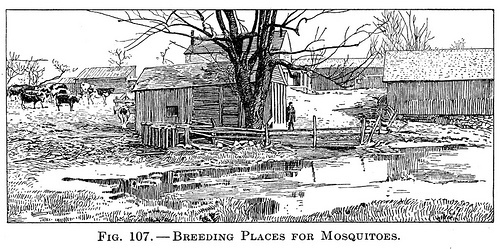
Throughout January and February, we’ve been focusing on perfecting those first drafts we wrote in November. Folks like Susan Bell, Marissa Meyer, and Hugh Howey have provided tomes of revision and publishing advice. As Camp NaNoWriMo’s April session approaches, we’re wrapping up our first-ever “Now What?” Months with our founder, Chris Baty:
Dear Novelists,
Once upon a time, there was a Panama Canal.
This is probably not the Panama Canal you’re thinking of. This was the first Panama Canal, attempted by the French in the late 1800s.
It was the most ambitious project the world had ever seen—not quite as tough as novel revision, but pretty close. France had just finished the Suez Canal, the Eiffel Tower dwarfed every structure on Earth, and French engineers had earned a reputation as bad-ass rock stars who could pull off the impossible.
France boldly sent hundreds of engineers to Panama, hired tens of thousands of laborers from around the world, and started digging. Nine years and $287,000,000 later, they wrapped up operations and sailed home. The canal was nowhere near finished; the undertaking had been a complete fiasco.
“We’re all about baked goods now,” said France.
Looking back, one of the biggest things separating France from success was actually very, very tiny.
It was a mosquito.
Two species of mosquitoes, to be precise. One transmitted yellow fever; the other malaria. They both lived and reproduced in happy abundance in the swamps, jungles, homes, and hospital wards of the canal zone. Thanks to those mosquitoes, the international labor force developed a bad habit of showing up for work and immediately dying.
This was not ideal for a lot of reasons.
But what, you might ask, does a failed French canal have to do with novel revision?
Let me tell you.
First drafts are full of literary mosquitoes—those noisome, unresolved questions that lurk in the eddies of our manuscripts and come out to bite us when we show up to work. I’m talking about plot holes, murky character motivations, redundant cast members, and a dozen other loose ends endemic to new stories.
Some people dive into their rewrites thinking they’ll just deal with all of these buggers as they go. Those people are rarely heard from again.
Because unless tackled head-on, literary mosquitoes will multiply, making you miserable and bleeding the momentum right out of your revision efforts. The key to a speedy and successful rewrite is taking a few weeks to eradicate the beasties before breaking ground on the next draft.
Thankfully, literary science has provided us with devastatingly effective tools for the job. Outlines, note cards, synopses, pitching your story to a friend and letting them ask questions… Basically anything that allows you to get above your story and help you spot the places where the buggers are breeding.
You’ll never quite get all of them, and that’s okay. Every hour of hard story work you put in now will save you a week of labor down the line.
When the Americans took over Panama Canal construction in 1904, laborers flooded back into the area, and a huge spike in deaths forced the US to finally get serious about mosquitoes. Thousands of workers were pulled off digging duty and put to work draining swamps, clearing brush, and screening windows.
Deaths from tropical disease plummeted. Productivity surged. And the Atlantic and Pacific were joined in oceanic matrimony on August 15, 1914. It was a pretty triumphant moment, but not quite as triumphant as the moment will be when you finish your novel. Not even close.
Chris Baty is the founder of NaNoWriMo and a Board Member Emeritus at the Office of Letters and Light. When not giving talks or toiling in the trenches of his own novel revision, Chris makes mosquito-repelling posters for writers.
February 25, 2013
Deductive Editing: Revising Like a Master Detective
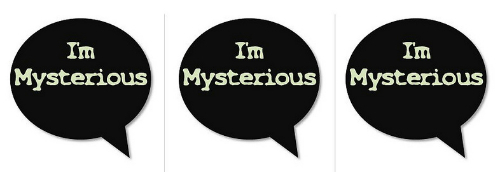
The “Now What?” Months have focused on guiding you through editing and pursuing publication for your NaNo-novel during January and February. Though February’s ending soon, Susan Bell, editor and author of The Artful Edit , encourages you to continue revising, and to think of it as unraveling the mystery of your manuscript:
Dear NaNoWriMo Author,
Last night, I began this letter seven times in seven different ways, and by the fifth attempt, my mind’s voice began to mutter, “Forget it, I can’t write a pep talk as clever and charming as the others on the NaNoWriMo website.” In despair, I went to bed. This morning, I woke up with a new idea, and knew it was the one I’d use; suddenly, life felt possible.
Writing anything, it turns out, is demanding. Your first idea and expression are rarely your finished work. So to achieve what you want as a novelist, remember the following truth: to write is to edit.
It’s a snore of a word, edit. It brings to mind doing the dishes after the meal, whereas “writing” evokes daily walks in a temperate wood, where birds serenade, and the only lightning that strikes is the world-altering thought in your head. Ah, the romance of writing. Raise your hand if your writing life involves daily forays into a melodious forest, where your explosive thoughts transform into ingenious words? No hands?
Perhaps, instead, you sit for hours trying to translate chaotic ideas onto a blank page, only to realize later that what you wrote isn’t right. Do not be discouraged. Editing is not the clean-up, it’s the meal. Look forward to it, because when you edit, the discovery of problems is cause for celebration (where else in life is that so?). Rejoice each time you find a sentence or character or chapter that doesn’t work, because if you don’t find a flaw, you can’t fix it.
If you think of it as detective work, editing is fun. Editors are narrative sleuths, who systematically hunt down the problems in a manuscript. There are macro-problems that have to do with, among other things, structure, dramatic tension, and character motivation; and there are micro-problems, which involve the artisanal details of sentence-making, such as precision and transitions.
A novel is so complex, that analyzing it can be overwhelming. A totally haphazard approach isn’t recommended. I only began to enjoy editing when I made it more methodical. When you read your draft, try using a checklist of potential narrative problems. During one read-through, check for unwanted repetition—of words, sentence structures, ideas. During another read-through, look for dull spots, where tension sags. If you get lost in your verbal thicket and forget what you were looking for, go back to your list.
While editing, like writing, is idiosyncratic, some certainties exist: unnecessary words clutter prose and obscure meaning, so prune them out; writing is musical, and relies on variation and rhythm, so don’t overuse the same syntax or sentence length.
To edit judiciously, you’ll need two things: concentration and stamina. These are easy to maintain if you swear off an excessive intake of alcohol, caffeine, sugar, and drugs. Didn’t I say editing was fun? Seriously, don’t mess with your clarity; it’s your ticket to a beautiful final draft. Clarity depends on its host’s good health. Get a good night’s sleep, stretch periodically, drink water. Writing can tolerate mood shifts and mystical visions. Editing cannot. If writers are shamans, editors are athletes.
Now that you’ve understood the virtues of editing, don’t go at it prematurely or obsessively. If overwriting is bad, so is overediting. Wait until you’ve written a completed section of some sort before you reread and rewrite. It’s critical to edit your novel, but it’s just as critical to write freely first.
In admiration of your efforts,

Susan Bell is the author of The Artful Edit: On the Practice of Editing Yourself . She has written for Vogue, The London Sunday Telegraph, and National Public Radio. A former editor at Random House , she created a seminar on self-editing for the New School’s Graduate Writing Program in New York City, and continues to teach there.
Photo by Flickr user Enokson.
February 22, 2013
Occupy Steve: How to Flesh Out Your Characters

Are you revising your novel during our “Now What?” Months? One of the toughest summits to climb can be breathing life into a character; Elizabeth Lyon, a longtime book editor, tells us how to fill their lungs:
Within the mass of pages you produced, some passages are breathtaking in how well they are written, even more have “potential,” and a number are destined for replacement. The prospect of revision may feel as though you’re anticipating a brutal climb up Mt. Everest without rope, ice axe, or map.
Sherpa guide Elizabeth Lyon at your service. First, breathe. Second, remember that you won’t be facing the terror of the blank page. Third, characterization is everything. Begin revision here. In the beginning, your characters were actors reading their lines. By the end of revision, they must become so real that your readers will love them, or fear to run into them on the street.
Transforming actors into unique and complex characters is the part of writing that most often derails the finished product. Characters with emotions keep readers biting nails, sighing, chortling, wishing, and tweeting, “You gotta read this book.” Chances are your draft is long on action. Hot writing produces pages, not contemplative pauses. So how do you turn your player pieces into three-dimensional “humans”?
Reset your tempo to largo; read page one and let yourself sink into your viewpoint character’s body. What is he or she sensing? Think of the usual: sound, smell, temperature and touch, taste, and sight. Most of us write early drafts visually, seeing the movie in our heads and translating these pictures into words. Fast writing can lead to over-reliance on descriptive sketches that are more camera-like than personal.
Let’s call your character Steve. He’s standing on a side street in downtown Seattle. Where specifically? GPS him. Look around—is he standing on the cracked, uneven sidewalk outside Burger Brothers? Near enough to hear the baritone blasts of the cruise ships at the pier? Or notice the rain pinging off the aluminum awning? Suddenly his attention is grabbed by an old green Pontiac roaring through a curbside puddle sending a spray over his secondhand boots and threadbare jeans. Damn it. The door opens behind him, and Steve’s stomach rumbles as he catches the smell of French fries sizzling in hot oil.
Be specific and the reader will slide right into the body of your character, eager for a vicarious ride.
Okay, we have Occupy Steve. So far so good. What is he feeling and why? Feelings supply motives, and thoughts provide a plan of action. Something is always happening to your characters, and he or she must react. If your character is mad, how mad? Miffed? Homicidal? How would he or she display fury? By kicking the chair over? Every heartbeat like flint on flint sparking a blaze of expletives?
We editors like to advise, “put emotions on the body.” Visceral or physical reaction first, then emotion and thought. After you’ve added reactions appropriate to the action, weave in thoughts—memories, concerns, and decisions—whatever drives your character into the next action. In other words, characterization drives plot.
Let’s revisit poor Steve. The door of the restaurant flies open and a man exiting slams into Steve. Action. The blow knocks the air out of his lungs and throws him hard on his left shoulder, already bruised badly. The pain pulses out blasts of hurt that light a blowtorch of rage. Not even a ‘sorry, mister’. Invisible. Nobody wants to see a homeless vet, or an addict, or a beat-up old man standing in the rain hoping for a handout. Steve struggles to his feet and stares after the well-dressed man. Steve clutches his shoulder and limps down the sidewalk. He’d catch the S.O.B. and make sure one man would never forget him.
Once you have occupied your characters, your reader will. They’ll vicariously experience the visceral and emotional actions and reactions, as well as the driving motives and needs of the characters. You’ve breathed life into the thinly draw actors of your fast draft. The reader now cares about them, and cares to know what happens next.
Read slowly, then stop. Look. Read slowly, then stop. Listen. To revise is to relive your story as Steve, as each and every one of your characters. Moment by moment. To the summit. The finish line.
Elizabeth Lyon has been a book editor since 1988. She is the author of many books for writers including the acclaimed Manuscript Makeover, and a soon-to-be released e-booklet series on writing.
Photo by Flickr user ClaraDon.
Headshot by Eric Griswold.
February 20, 2013
Nora Zelevansky: Be Kind to Yourself While You Edit

Nora Zelevansky is no stranger to revision. A longtime journalist, editing has been a mandate from the very beginning. Still, revising her first novel, Semi-Charmed Life was no walk in the park. As our “Now What?” Months begin to wind down, Nora tells revisors to cut themselves a break:
Dear Writers,
There is a long-standing debate among us about which is more daunting: a blank page or a rough draft. Historically, I consider myself a stalwart of the former camp; something seems preferable to nothing. At least, I thought I felt that way until I recently finished the first draft of a new manuscript, stared into the editing abyss, and promptly developed a case of vertigo.
In 2009, I participated in National Novel Writing Month for the first time. Along with thousands of others, I aimed to write 1,667 words every day for a month in hopes of manifesting an honest-to-goodness book. I hemmed and hawed with the best of them, but ultimately relished the process of letting my imagination steer.
That year, when I finished the original manuscript, I started editing right away. As a journalist, editing is second nature to me: you write, you chop, you edit, you polish. That’s how it works. And I was fortunate: in December of the next year, St. Martin’s Press offered to publish the book. And in July 2012, my novel hit bookstores.
This past fall, the hoopla quieted. The time had come to sit down and write another book during November. This time, writing the first draft was a little more strenuous. Expectations and self-imposed pressure loomed large, but I kept reminding myself that I could always rewrite. No big deal, right?
Wrong. Once I finished the first draft and had to begin the edit, I felt more overwhelmed than ever. I realized, no matter where you are in your journey as a writer, the editing and notes process remains arduous and stressful. It will always test you.
I am currently awaiting notes. And I am terrified. I know that I’ll likely be facing down some overarching issues without easy fixes. But I want to rewrite and take notes because I want my book to be as good as possible. We all feel that way, of course. Still, “daunting” doesn’t begin to describe the feeling of staring at a document that you created, wondering how the hell you’re going to take it to a final draft.
Be kind to yourself. As hard as it is, try to remember that Rome wasn’t built in a day. Even award-winning authors have to rewrite. A first draft is never the final product. Don’t give up.
Ultimately, rewriting is hard. Maybe even harder than staring at a blank page. So I say, applaud yourself for the effort and enjoy the miraculous moments when an edit works and the language begins to click. And I will try to do the same. After all, there are few things as satisfying as that.
Nora Zelevansky is a novelist, journalist, essayist, and editor, whose writing has appeared in Elle and Salon. Her debut novel Semi-Charmed Life hit shelves in July 2012. The first in a two-book deal with St. Martin’s Press, the novel draws on her childhood with art-world parents on Manhattan’s Upper West side.
Keep up with Nora:
At norazelevansky.com
On Twitter
On Facebook
Top photo by Flickr user Marcin Wichary.
Chris Baty's Blog
- Chris Baty's profile
- 63 followers


